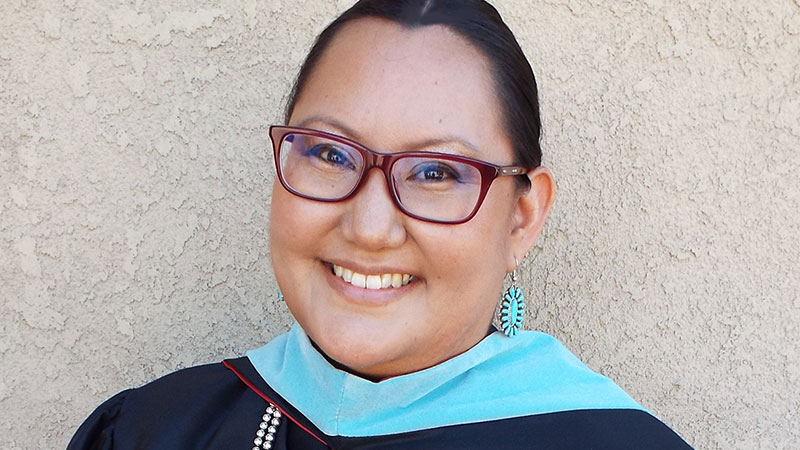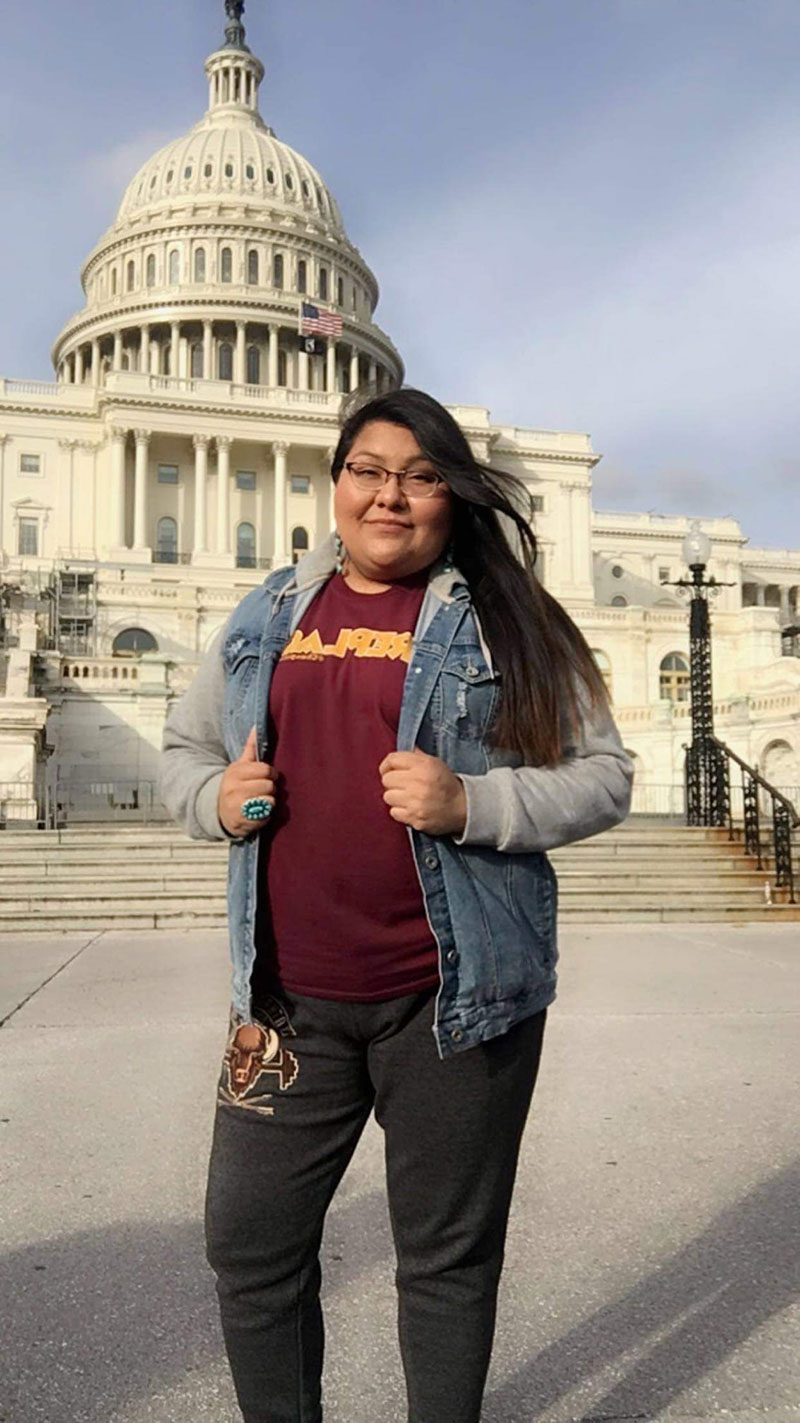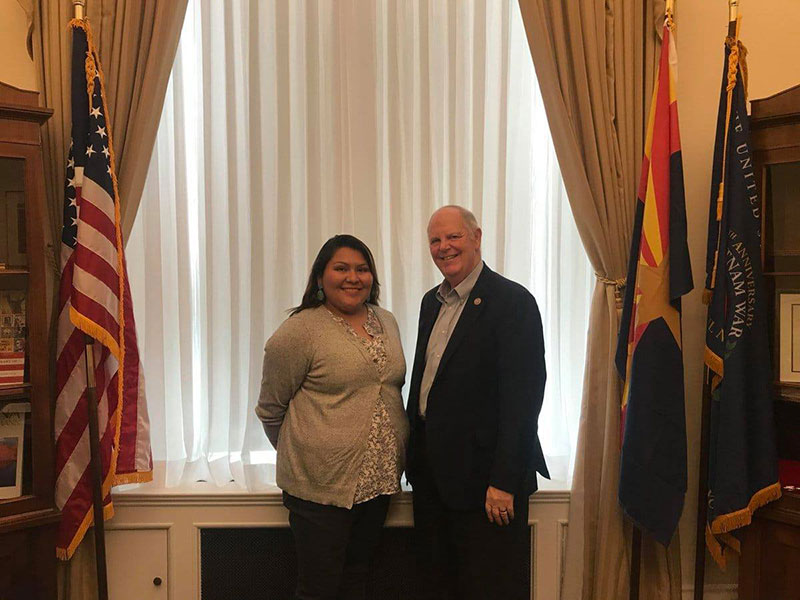Degree Spotlight: Native American Studies
September 22, 2021 - Rick Robb / Staff

While people interested in making positive change in Tribal Communities often consider a Bachelor of Arts in Native American Studies (NAS), they may not be sure what the degree offers. At UNM’s department of Native American Studies, Senior Student Success Specialist, Catherine Montoya, Ed.D. (Diné), shares her insight.
“A lot of people don't quite understand what Native American Studies is or how it can help them in their academic pursuits or in their professional careers,” Montoya said. “I think we get that question quite a bit.”
Montoya is uniquely qualified to answer questions about NAS. In addition to supporting Native programs for 14 years, she recently graduated as a Doctor of Education (Ed.D.) in Educational Leadership from the UNM EDD-LEAD’s inaugural Native American Leadership in Education (NALE) cohort.
In the following video, she and other NAS faculty detailed the diverse opportunities for graduates of the program.
“Foundation in Activism, and It Continues to This Day”
UNM’s first Native American organization, Kiva Club, was the origin of the NAS academic department. The group brought attention to the many social issues affecting Native Americans and was influential in making recommendations to the university. Momentum started in the 1970s with the development of Native-based curricula. By 1999 a minor was established leading to the launch, in 2005, of the Bachelor of Arts in Native American Studies.
Montoya began working at the University of New Mexico in 2007 and joined the NAS department in 2016. Realizing a need for NAS to reach a larger audience, in 2017 she helped to roll out the online B.A. in Native American Studies, offering a concentration in Leadership and Building Native Nations. The degree program’s background and content all stay true to the Kiva Club’s vision.
“The Native American Studies program has its foundation in activism, and it continues to this day,” Montoya explained. “Our students gain critical consciousness in our courses." The program focuses on issues impacting Native peoples today. Through research and by engaging in open and safe conversations, students examine the many influences upon Native people ranging from issues faced by Tribal governments to topics on leadership, policymaking, Indigenous education, and language revitalization efforts.
For example, Montoya taught a class this past summer on Indigenous Self-Determination in Education—NATV 305. “In that class,” Montoya explained, “one of the topics that came up was about the boarding schools and the issues that were happening and why they were created. It was really neat to see the class start to connect contemporarily with some of the issues about the boarding schools recently reported in the news; not only in Canada but bringing awareness [to similar problems] here in the United States.”
“In addition to that, I think that race and talking about how it impacts students in so many different ways was a really big topic of discussion in our online class,” Montoya went on to say. “I could see how the students were relating to that—our Indigenous students and our non-Indigenous students—everybody having that chance to explore and to really dive deep and think about how it has impacted us.”
Preparing Students for Versatile Career Opportunities

Montoya was quick to point out that exploring Indigenous issues deepens a student’s outlook which, in turn, are linked to students’ careers and future intentions. “How is it important for them?” she asked. “How are they able to connect to what they're learning? And how are they able to apply it as well?”
Montoya answered the questions, saying, “In our program, we offer opportunities for students to dive a little bit deeper, and they can choose between doing an internship or an independent study as a major in our program. We really encourage them to connect with an Indigenous community. We want students who are both in the program and residing outside of New Mexico to connect to an Indigenous community that is local to them.”
NAS offers incredible knowledge diversity. Students come to understand the impacts on Native people when, for example, decisions are made regarding education, water rights, or social programs at the city, state, and federal level. Such awareness may ignite a graduating student’s interest in pursuing advanced degrees in areas such as law or health and wellness. There isn’t a single path in the NAS program.
“What I like to do when I meet with students new to the program is work with them and think about what kind of goal they have for themselves,” Montoya said. “What is it they see coming out of NAS that they would like to apply in what they do for their work? Based on that, I’ll help them develop their degree plan and think about what other programs they want to put together.” She notes that it’s possible for students to double-major in a certain area for instance or maybe to add a particular minor that will enhance what they're learning in the NAS program.
“Oftentimes they already have an idea, and it's just helping them foster that idea and helping them reach those goals,” explains Montoya “So not only am I helping them prepare through the NAS bachelor's program, but I'm helping them think about their future; what kind of graduate degree program are they interested in, or career goals do they have—and how can we help them head that direction?”
What do NAS students do with their degree following graduation? The possibilities students might consider are varied.
- They may work in Native American community-based nonprofit organizations or in tribal, state, or federal agencies.
- Law is a big interest, and a lot of students go on to law school to learn how to help influence tribal, state, or federal policymaking.
- Some go to grad school, whether it’s an MA in NAS or another field such as teaching, public administration, community health, water resources, community & regional planning, counseling, or an area like language, literacy, and sociocultural studies.
- Students often combine NAS with a minor in areas such as psychology, business administration or communications/journalism to explore various career opportunities.

One standout success story comes from Erla Sagg, the first person to complete the online NAS program. Living part-time in Arizona and Washington, DC, the student only met Montoya twice. Once was to get details on enrolling in the program and the other when attending the graduation ceremony. The determined student took advantage of the accelerated format and quickly completed the bachelor's program within two years. During the last semester of the online bachelor program, she attended George Washington University's Native American Political Leadership Program to fulfill an internship requirement for the online program. She went on to earn a Master's degree in NAS from UNM while also working for the National American Indian Housing Council. Today she is still in Washington, DC, working as a Communications Officer for the Navajo Nation Washington Office.
Why Study NAS at UNM Instead of Another Institution?
“I feel like we have a very special program in Native American Studies,” Montoya said. “What's really unique about us is that we have all-Native faculty and there's that really strong connection to Tribal communities.”
UNM’s program is rooted in the reality and tradition of Native American communities, setting itself apart with such a strong focus on Nation-building and engaging students in exploring important issues.
“I think that our program is quite unique in that way,” said Montoya. “With our program we really want our students to develop themselves in a way where they can answer some of those questions about issues that are happening and learn how they can help make a difference.”
If you’re interested in making a positive impact on Tribal communities and accomplishing your career goals with UNM’s accelerated online program, take a look at the detailed program page for more information about the B.A. in Native American Studies.
Ready to discover how the program can fit your goals?
